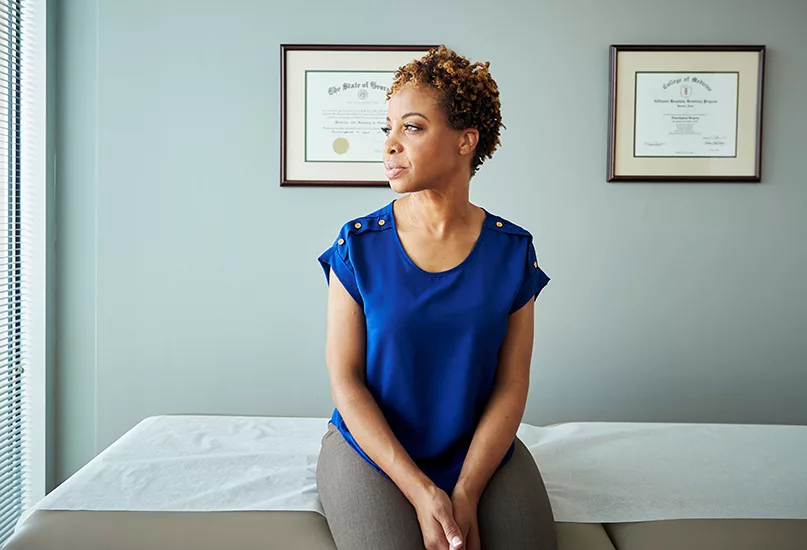The gender health gap is a matter of life or death, with women’s health under-researched, overlooked, and stigmatised. We put inequality and issues such as mistreatment and misdiagnoses under the microscope.
MISOGYNY IN MEDICINE
Global healthcare is undergoing unprecedented transformation, driven by technological advancements, demographic shifts, and the ever-changing needs of patients.
The industry has experienced rapid evolution, but it is also encountering a revolution in medicines and procedures. However, one key component has remained the same – its approach towards women’s health, resulting in biological and gender-related discrimination.
Inequality and prejudice in healthcare have a significant impact on the diagnosis and treatment of patients, with studies showing that doctors are more likely to misdiagnose women and take longer to accurately diagnose their conditions.
Additionally, women are less likely to be offered pain medication, with their symptoms being dismissed as anxiety or a figment of the imagination.
For instance, abdominal pain is frequently written off as period cramps, while painful conditions such as uterine fibroids, endometriosis, and ovarian cysts go undiagnosed for months or even years, leading to permanent damage that could have been avoided if properly addressed sooner.
Despite advances and advocacy efforts in recent decades, maternal mortality rates in many countries remain high and could have been prevented.
Often rooted in sociocultural factors, male-centred research, gender stereotypes, and biased medical textbooks, the impact of these disadvantages contributes to increased vulnerability to all types of illnesses, diseases, and abuse.
Moreover, poverty poses an obstacle to achieving positive medical outcomes, and while it affects both men and women, female health bears a disproportionately higher burden.
Financial hardship also reduces access to education and employment opportunities, leading to malnutrition, unaffordable menstrual products and hygiene facilities, and the inability to afford health insurance and essential pharmaceuticals.
Black and minority ethnic women fare even worse. In the UK, Black women are four times more likely to die in childbirth compared to their white counterparts.
Meanwhile, in the US, there are disparities in diabetes and cancer mortality for Black and American Indian and Alaska Native (AIAN) women, as well as challenges in accessing affordable and quality care.
MYTHS AND MISDIAGNOSIS
Women’s bodies have been a mystery to the medical sector for centuries, and healthcare has consistently reinforced socially constructed gender divisions.
Traditionally, biology has primarily focused on studying the male anatomy. At the same time, female bodies have been an enigma, described as “small men” by early medical authorities due to the lack of external genitalia and a perceived lower mental capacity attributed to humours and hormones.
Throughout history, women were often portrayed as overly emotional hypochondriacs, with the prevailing belief that their intense emotions had significant effects on their physical health. In the past, some physicians thought that women’s nerves were too sensitive for them to pursue education and that excessive reading could lead to inflammation of their ovaries.
The medical establishment has minimised women’s concerns to the extent that they are more likely to apologise for their ailing or unruly bodies – a legacy that continues to impact the lives of female patients to this day.
Doctors and other medical professionals have revealed that women still feel the need to apologise for being in pain, seeking advice, or pushing for proper healthcare despite the emergence of healthcare activists in the 1960s.
Feminist campaigners fought tirelessly for women’s reproductive rights during that decade and into the 1970s. Access to contraception and legalising abortion became hot-button issues, which have continued into the 21st century. Changing childbirth practices and education have saved countless lives and allowed women agency over their bodies.
Yet, pregnancy aftercare in the form of providing support for post-partum depression and psychosis is relatively new, as the medical profession did not officially recognise the debilitating condition until the 1990s.
However, the dismissal of women’s pain is not exclusive to gynaecological or pregnancy-related conditions; misdiagnosing depression, cardiovascular disease, and many types of cancer are also disappointingly common.
In the late 1800s, a prominent figure in modern medicine declared that women exhibiting signs of a heart attack or arrhythmia were experiencing “pseudo angina” – a set of neurosis-induced symptoms.
Furthermore, as jaw and back pain are commonly experienced by women during a heart attack but are not frequently observed in men, doctors may not take these symptoms as seriously.

ALL IN THE MIND
The stigma surrounding women’s mental health is embedded in various aspects of the healthcare industry, including eating disorders, gynaecological issues, menstrual health, and menopause.
According to the prestigious medical journal, The Lancet, attitudes towards menopause are evolving as the healthcare industry recognises the lack of treatment has led women to seek help from the wellness industry, which may not be science-led.
The negative connotations in society surrounding menopause stem from it symbolising the end of a woman’s fertility, reflecting the broader issue of women being valued primarily for their reproductive abilities.
Facets may have changed from when women were prescribed a ‘rest cure’ for post-partum depression, as depicted in literary works such as Charlotte Perkins Gilman’s “The Yellow Wallpaper”.
In the 1800s, women had very few rights, especially when it came to their mental health and those who displayed behaviour that male society disapproved of were often confined to asylums. Later research has shown that the reasons for admitting these women to such institutions were often dubious at best.
Today, there is a better understanding of mental health issues, improved therapy techniques, and advancements in treatment. Nevertheless, there are still unmet needs, and anxiety and depression are on the rise due to the stress of modern-day life.
Additionally, women encounter distinct challenges when dealing with addiction, often experiencing higher levels of guilt and shame influenced by gender-specific roles such as caregiving.
Women also experience barriers in accessing drug rehabilitation and support centres, which are typically male-dominated. As a result, they may be held back from their recovery journey and are prone to relapse.
Societal expectations, gender norms, and the normalisation of specific emotional struggles contribute to women’s mental health being overlooked and inadequately addressed. Access to crucial support and treatment is often insufficient, leading to undiagnosed disorders.
SHATTERING THE SILENCE
Upon entering the doctor’s office, women are often faced with the daunting task of advocating for themselves. Despite their valid concerns, many encounter dismissive attitudes and are labelled hysterical or overdramatic.
Pervasive weight stigma in the medical sector, meanwhile, leads to the belief that most health conditions can be resolved solely through diet and exercise.
Unfortunately, a brief internet search will reveal numerous case studies of women who have been disappointed by healthcare providers, with some experiencing tragic consequences.
Injustices such as being offered minor tranquilisers, weaker painkillers, and antidepressants as a universal solution explain why many women report feeling invisible, frustrated, or ashamed in medical environments.
Healthcare organisations largely function as interventive rather than preventive, and empowering women is not considered a priority since services are fragmented.
In addition to the dismissive attitudes and ingrained misogyny wrought within the system, bureaucracy is another significant issue, leading to women facing discrimination on multiple levels.
By treating female patients as individuals, avoiding stereotyping, and understanding the magnitude of unconscious bias, the healthcare industry can make improvements and changes, creating a safer, more inclusive environment where women can enjoy longevity free from unnecessary pain and potentially life-threatening illnesses and conditions.
Paperwork, wait times, and patient scheduling are out of the doctor’s control, and the system they operate in must be revised. It should also be noted that many medical professionals are working to improve healthcare for women.
In the US, the bureaucratic process leads many physicians to burn out, with increasing pressure to see more patients. Nevertheless, women must continue to advocate for themselves, their health, and a healthcare future that promotes equality for every patient.


























